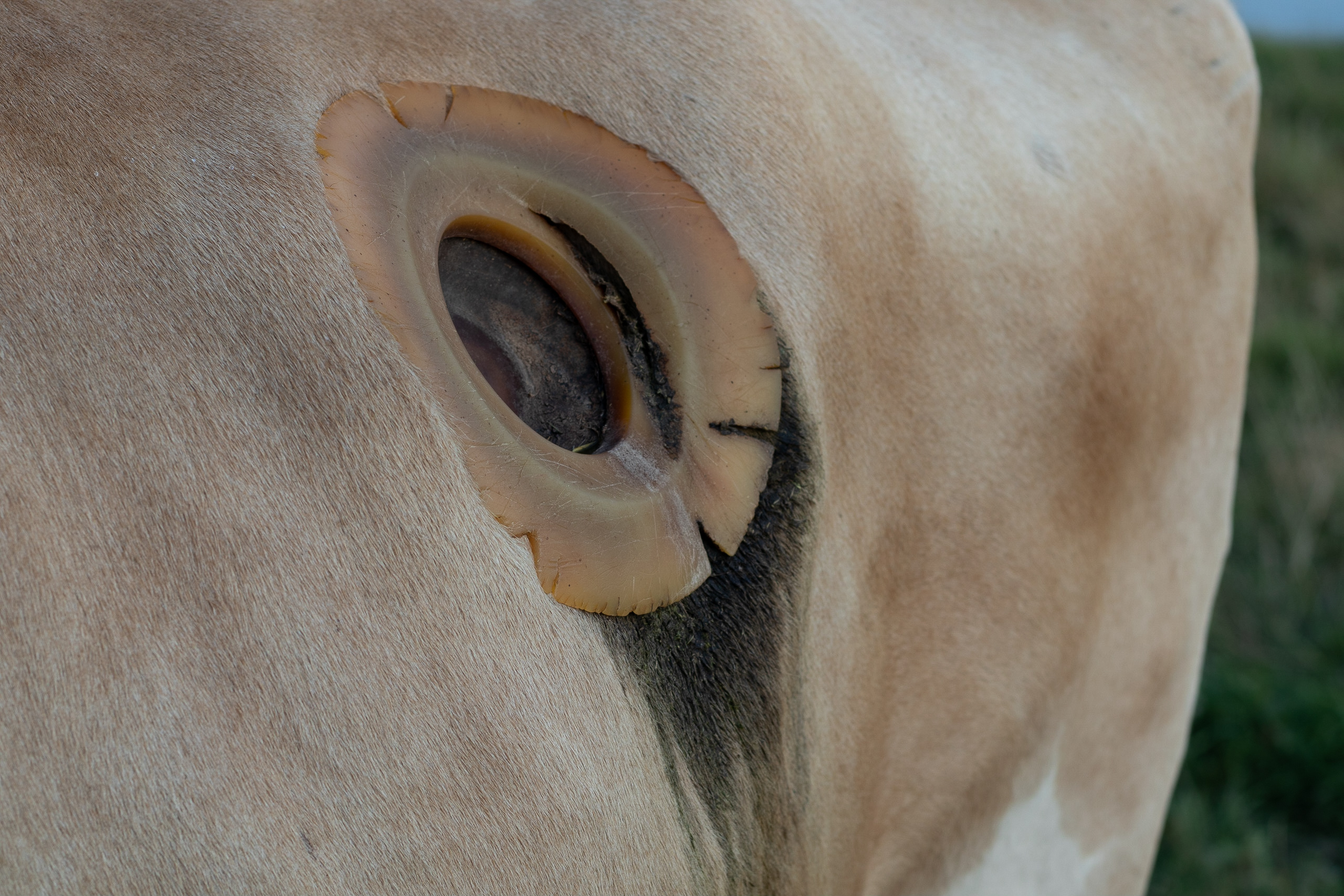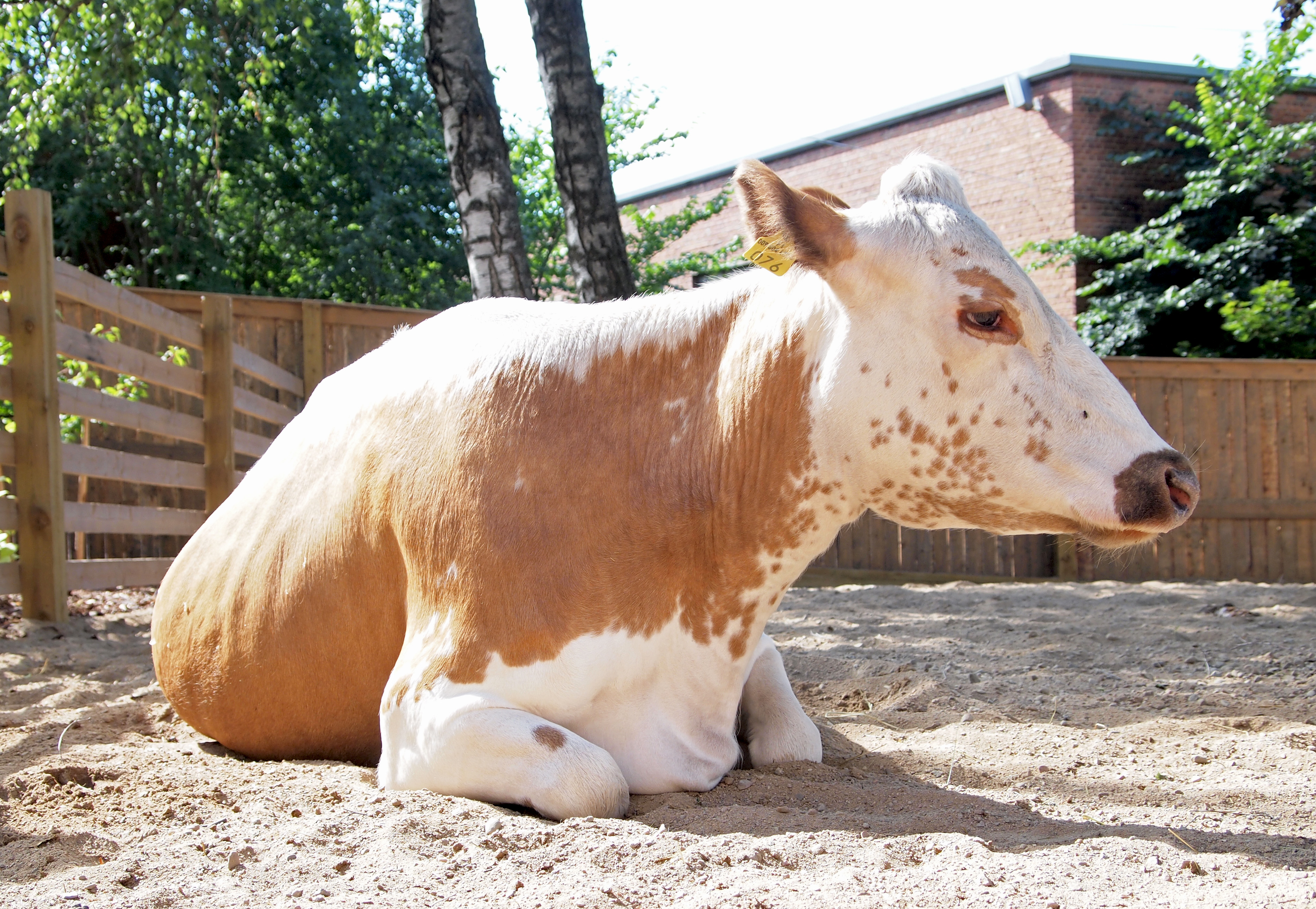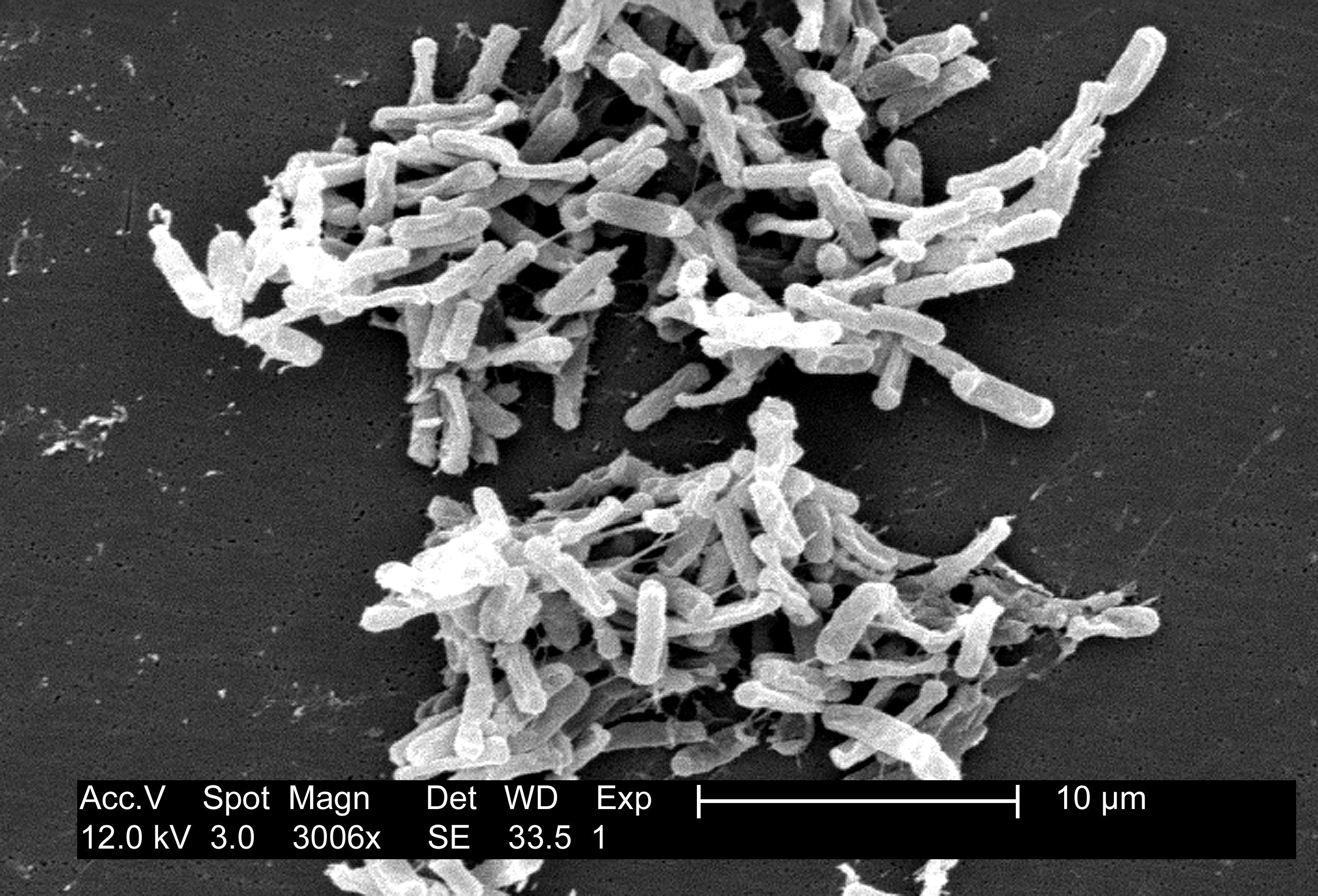|
Cannulated Cow
A cannulated cow or fistulated cow refers to a cow that has been surgically fitted with a cannula. A cannula acts as a porthole-like device that allows access to the rumen of a cow, to perform research and analysis of the digestive system and to allow veterinarians to transplant rumen contents from one cow to another. The practice of rumen cannulation was first documented in 1928 by Arthur Frederick Schalk and R.S. Amadon of North Dakota Agricultural College. Surgical implantation Cannulation requires installing a flanged rubber cylinder in the side of a cow, behind its 13th rib. The cylinder typically is fitted with a plastic, rubber, or metal cap to keep the rumen anaerobic. The rubber cannula is surgically implanted while the cow is standing and awake, with local anesthetic. The cow is made to fast and refrain from drinking water for 24 hours in advance of the surgery. Then the veterinarian excises a small piece of the cow's skin, makes an incision through the rumen, and sti ... [...More Info...] [...Related Items...] OR: [Wikipedia] [Google] [Baidu] |
Cow Disc 5201
Cattle (''Bos taurus'') are large, domestication, domesticated, Cloven hoof, cloven-hooved, herbivores. They are a prominent modern member of the subfamily Bovinae and the most widespread species of the genus ''Bos''. Adult females are referred to as cows and adult males are referred to as bulls. Cattle are commonly raised as livestock for meat (beef or veal, see beef cattle), for milk (see dairy cattle), and for hide (skin), hides, which are used to make leather. They are used as riding animals and draft animals (oxen or wikt:bullock, bullocks, which pull carts, plows and other implements). Another product of cattle is Cow dung, their dung, which can be used to create manure or fuel. In some regions, such as parts of India, Cattle in religion, cattle have significant religious significance. Cattle, mostly small breeds such as the Miniature Zebu, are also kept as pets. Different types of cattle are common to different geographic areas. Taurine cattle are found primarily in Eu ... [...More Info...] [...Related Items...] OR: [Wikipedia] [Google] [Baidu] |
Abomasum
The abomasum, also known as the maw,The Chambers Dictionary, Ninth Edition, Chambers Harrap Publishers, 2003 rennet-bag, or reed tripe, is the fourth and final compartment in . It secretes , which is used in creation. The word ''abomasum'' (''ab-'' "away from" ... [...More Info...] [...Related Items...] OR: [Wikipedia] [Google] [Baidu] |
Metabolism
Metabolism (, from el, μεταβολή ''metabolē'', "change") is the set of life-sustaining chemical reactions in organisms. The three main functions of metabolism are: the conversion of the energy in food to energy available to run cellular processes; the conversion of food to building blocks for proteins, lipids, nucleic acids, and some carbohydrates; and the elimination of metabolic wastes. These enzyme-catalyzed reactions allow organisms to grow and reproduce, maintain their structures, and respond to their environments. The word metabolism can also refer to the sum of all chemical reactions that occur in living organisms, including digestion and the transportation of substances into and between different cells, in which case the above described set of reactions within the cells is called intermediary (or intermediate) metabolism. Metabolic reactions may be categorized as ''catabolic'' – the ''breaking down'' of compounds (for example, of glucose to pyruvate by ce ... [...More Info...] [...Related Items...] OR: [Wikipedia] [Google] [Baidu] |
Veterinary Equipment
Veterinary medicine is the branch of medicine that deals with the prevention, management, diagnosis, and treatment of disease, disorder, and injury in animals. Along with this, it deals with animal rearing, husbandry, breeding, research on nutrition, and product development. The scope of veterinary medicine is wide, covering all animal species, both domesticated and wild, with a wide range of conditions that can affect different species. Veterinary medicine is widely practiced, both with and without professional supervision. Professional care is most often led by a veterinary physician (also known as a veterinarian, veterinary surgeon, or "vet"), but also by paraveterinary workers, such as veterinary nurses or technicians. This can be augmented by other paraprofessionals with specific specialties, such as animal physiotherapy or dentistry, and species-relevant roles such as farriers. Veterinary science helps human health through the monitoring and control of zoonotic disease (i ... [...More Info...] [...Related Items...] OR: [Wikipedia] [Google] [Baidu] |
Veterinary Diagnosis
Veterinary medicine is the branch of medicine that deals with the prevention, management, diagnosis, and treatment of disease, disorder, and injury in animals. Along with this, it deals with animal rearing, husbandry, breeding, research on nutrition, and product development. The scope of veterinary medicine is wide, covering all animal species, both domesticated and wild, with a wide range of conditions that can affect different species. Veterinary medicine is widely practiced, both with and without professional supervision. Professional care is most often led by a veterinary physician (also known as a veterinarian, veterinary surgeon, or "vet"), but also by paraveterinary workers, such as veterinary nurses or technicians. This can be augmented by other paraprofessionals with specific specialties, such as animal physiotherapy or dentistry, and species-relevant roles such as farriers. Veterinary science helps human health through the monitoring and control of zoonotic disease (i ... [...More Info...] [...Related Items...] OR: [Wikipedia] [Google] [Baidu] |
Cattle
Cattle (''Bos taurus'') are large, domesticated, cloven-hooved, herbivores. They are a prominent modern member of the subfamily Bovinae and the most widespread species of the genus ''Bos''. Adult females are referred to as cows and adult males are referred to as bulls. Cattle are commonly raised as livestock for meat (beef or veal, see beef cattle), for milk (see dairy cattle), and for hides, which are used to make leather. They are used as riding animals and draft animals ( oxen or bullocks, which pull carts, plows and other implements). Another product of cattle is their dung, which can be used to create manure or fuel. In some regions, such as parts of India, cattle have significant religious significance. Cattle, mostly small breeds such as the Miniature Zebu, are also kept as pets. Different types of cattle are common to different geographic areas. Taurine cattle are found primarily in Europe and temperate areas of Asia, the Americas, and Australia. Zebus (also ... [...More Info...] [...Related Items...] OR: [Wikipedia] [Google] [Baidu] |
Scurvy
Scurvy is a disease resulting from a lack of vitamin C (ascorbic acid). Early symptoms of deficiency include weakness, feeling tired and sore arms and legs. Without treatment, decreased red blood cells, gum disease, changes to hair, and bleeding from the skin may occur. As scurvy worsens there can be poor wound healing, personality changes, and finally death from infection or bleeding. It takes at least a month of little to no vitamin C in the diet before symptoms occur. In modern times, scurvy occurs most commonly in people with mental disorders, unusual eating habits, alcoholism, and older people who live alone. Other risk factors include intestinal malabsorption and dialysis. While many animals produce their own vitamin C, humans and a few others do not. Vitamin C is required to make the building blocks for collagen. Diagnosis is typically based on physical signs, X-rays, and improvement after treatment. Treatment is with vitamin C supplements taken by mouth. Improvemen ... [...More Info...] [...Related Items...] OR: [Wikipedia] [Google] [Baidu] |
PETA
Peta or PETA may refer to: Acronym * Pembela Tanah Air, a militia established by the occupying Japanese in Indonesia in 1943 * People for the Ethical Treatment of Animals, an American animal rights organization * People Eating Tasty Animals, an organization mocking the People for the Ethical Treatment of Animals' stance on vegetarianism * Philippine Educational Theater Association, a Philippine theatrical association * Pulse Ejector Thrust Augmentor, a type of jet engine People * Peta (given name), including a list of people and fictional characters with the name * Tomasz Peta (born 1951), Roman Catholic Archbishop of the Metropolitan Archdiocese of Saint Mary in Astana, Kazakhstan Places * Peta, Greece, a town * Peţa River, a river in Romania Other uses * peta-, a metric prefix denoting a factor of 1015 * Battle of Peta * Peta (cat), the unofficial Chief Mouser to the UK Cabinet Office 1964-78 * Mysore peta, a type of Indian royal attire * Pentaerythritol tetraacrylat ... [...More Info...] [...Related Items...] OR: [Wikipedia] [Google] [Baidu] |
Fistulation
A fistula (plural: fistulas or fistulae ; from Latin ''fistula'', "tube, pipe") in anatomy is an abnormal connection between two hollow spaces (technically, two epithelialized surfaces), such as blood vessels, intestines, or other hollow organs. Types of fistula can be described by their location. Anal fistulas connect between the anal canal and the perianal skin. Anovaginal or rectovaginal fistulas occur when a hole develops between the anus or rectum and the vagina. Colovaginal fistulas occur between the colon and the vagina. Urinary tract fistulas are abnormal openings within the urinary tract or an abnormal connection between the urinary tract and another organ such as between the bladder and the uterus in a vesicouterine fistula, between the bladder and the vagina in a vesicovaginal fistula, and between the urethra and the vagina in urethrovaginal fistula. When occurring between two parts of the intestine, it is known as an enteroenteral fistula, between the small intesti ... [...More Info...] [...Related Items...] OR: [Wikipedia] [Google] [Baidu] |
Fecal Microbiota Transplant
Fecal microbiota transplant (FMT), also known as a stool transplant, is the process of transferring fecal bacteria and other microbes from a healthy individual into another individual. FMT is an effective treatment for ''Clostridioides difficile'' infection (CDI). For recurrent CDI, FMT is more effective than vancomycin alone, and may improve the outcome after the first index infection. Side effects may include a risk of infections, therefore the donor should be screened. FMT involves restoration of the colonic microflora by introducing healthy bacterial flora through infusion of stool via colonoscopy, enema, orogastric tube, or by mouth in the form of a capsule containing feces from a healthy donor, which in some cases is freeze-dried. With CDI becoming more common, FMT is gaining increasing prominence, with some experts calling for it to become the first-line therapy for CDI. FMT has been used experimentally to treat other gastrointestinal diseases, including colitis, ... [...More Info...] [...Related Items...] OR: [Wikipedia] [Google] [Baidu] |
Cannula
A cannula (; Latin meaning 'little reed'; plural or ) is a tube that can be inserted into the body, often for the delivery or removal of fluid or for the gathering of samples. In simple terms, a cannula can surround the inner or outer surfaces of a trocar needle thus extending the effective needle length by at least half the length of the original needle. Its size mainly ranges from 14 to 24 gauge. Different-sized cannula have different colours as coded. Decannulation is the permanent removal of a cannula (extubation), especially of a tracheostomy cannula, once a physician determines it is no longer needed for breathing. Medicine Cannulas normally come with a trocar inside. The trocar is a needle, which punctures the body in order to get into the intended space. Many types of cannulas exist: Intravenous cannulas are the most common in hospital use. A variety of cannulas are used to establish cardiopulmonary bypass in cardiac surgery. A nasal cannula is a piece of plastic tu ... [...More Info...] [...Related Items...] OR: [Wikipedia] [Google] [Baidu] |
Forage Analysis
Forage analysis is an integral part of modern animal production. Livestock managers require detailed information about the feedstuffs of their herds in order to best achieve production goals, whether they are concerned with economic efficiency, nutrient efficiency or maximum yields. There are various methods of analysing livestock diets for different constituents all differing in expense, time, and accuracy. The focus of most studies is the following three main attributes; Metabolisable Energy (MJ/Kg), Protein Proteins are large biomolecules and macromolecules that comprise one or more long chains of amino acid residues. Proteins perform a vast array of functions within organisms, including catalysing metabolic reactions, DNA replication, res ... content (%) and Fibre content (%). References External links * Interpreting Forage and Feed Analysis Reports Mississippi State University Extension Service Forage Analysis Interpretation Montana State University Exten ... [...More Info...] [...Related Items...] OR: [Wikipedia] [Google] [Baidu] |








